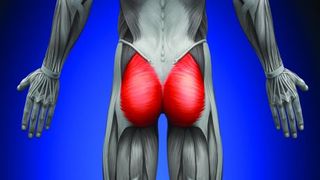How to get bigger glutes: Why train them?
Want a behind that helps your sports performance and attracts admiring glances? Then start training it

Bret Contreras is one of the world’s leading experts on glute training. With a PhD in sports science, he’s been certified as a strength and conditioning specialist by the US National Strength and Conditioning Association and is the co-founder of the Strength & Conditioning Research Review. Here, the self-described ‘shaper of thousands of better butts worldwide’ explains why glute training is vital and how you can adapt it to suit your training goals.
Why glutes?
Plenty of men train their legs at the gym, but you’ll rarely see them working specifically on their glutes – unlike women, who are usually only too keen to focus on them. This is partially due to a lot of popular industry advice that gives guys the impression that a few squats and deadlifts once a week are all they need to do to train their lower body. But if you want to reduce your risk of injury and maximise your sporting performance, not to mention build a behind that’s attractive to the opposite sex, training your legs at least twice a week and making time for glute-focused work is a must.
Performance
Strengthening your glutes will improve your ability to run, jump, squat, deadlift and compete in pretty much any sport, but you need to be doing the right exercises. I see a lot of guys in the gym just do leg presses, leg extensions and leg curls, none of which work your glutes effectively.
My favourite exercises for building glute strength are kettlebell swings, walking lunges and American deadlifts, which are similar to Romanian deadlifts, but you squeeze your glutes at the top of the move. The key with the kettlebell swings is to use a heavy kettlebell that allows you to work in a lower, strength-building rep range, but you have to make sure you can maintain good form. I started out with a 48kg kettlebell and worked my way up to 92kg. If you’re relatively new to training I’d suggest mastering the deadlift first before moving on to heavy kettlebell swings.
Mobility
Having tight glutes is a common problem and one that can restrict hip mobility, which has a negative impact on strength and sporting performance. Maintaining good form and going deep during the eccentric phase of a lift will combat this by lengthening your glutes, especially during Bulgarian split squats. I also recommend foam rolling and mobility drills [see the box, right] both pre-workout and as a standalone session if you have the time.
Looks
Adding muscle to your glutes will build an aesthetically pleasing rear end. To do this I recommend adding exercises to your workouts that isolate your glutes, such as hip thrusts, back extensions (placing the emphasis on your glutes) and goblet squats. Hip thrusts are great because they keep constant tension on your glutes and take your hamstrings out of the equation, which leads to more glute activation. Plus unlike other leg exercises, your ability to progress isn’t limited by your core strength.
Bum deal
Loosen your glutes for improved mobility with Contreras’s simple drills
Get the Coach Newsletter
Sign up for workout ideas, training advice, reviews of the latest gear and more.
Goblet squat - Sets 2 Reps 8
- Stand holding a light kettlebell or dumbbell close to your chest.
- Squat down until your hamstrings are touching your calves, keeping your chest and head up and your back straight.
- At the bottom position, pause and use your elbows to push your knees out, then return to the starting position.
Walking knee hug - Sets 2 Reps 5 each leg
- Stand tall with your arms at your side and feet shoulder-width apart.
- Lift your left knee up.
- then grab your shin with both hands and pull it as close to your chest as you can without discomfort.
- Release, step forward and repeat on your other leg.
Multi-directional lunge - Sets 2 Reps 5 each direction
- Step your right foot forward into a lunge, keeping your back straight and ensuring your knee doesn’t go past your foot.
- Return to the start and perform a side lunge to your right, followed by a reverse lunge behind you and a side lunge to your left, completing a clockwise circle. This is one rep.
Coach is a health and fitness title. This byline is used for posting sponsored content, book extracts and the like. It is also used as a placeholder for articles published a long time ago when the original author is unclear. You can find out more about this publication and find the contact details of the editorial team on the About Us page.

